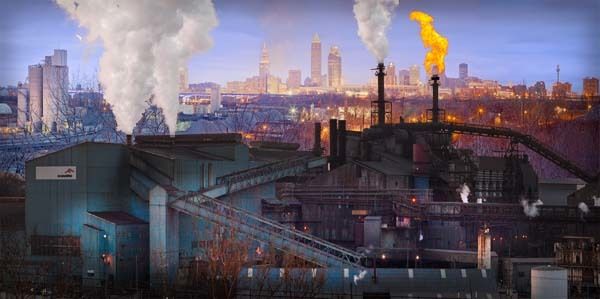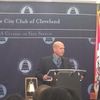In a New Year’s Day op-ed entitled “A Year That Can Never Be Taken From Cleveland”, New York Times contributor John Hyduk—a Cleveland-based loading-dock worker—wrote the past year brought with it a “buoyancy that started between the lines in the ballpark and the basketball arena and has spilled out, largely undiminished, into some of the less scenic corners of the city”.
I think many Clevelanders can agree with that: the city has some swag back.
Still, Cleveland has been here before.
A 1995 New York Times piece entitled “The 'Mistake by the Lake' Wakes Up, Roaring” detailed how the Cleveland Indian’s play that year—combined with the opening of the city’s arena district— created for an air of “self-congratulation in Cleveland” owed to a “new face and new style of a city that for a long time had little panache.”
But the panache puttered out by the aughts. The 2000s were a brutal decade for Cleveland, a beating delivered by deindustrialization and the subprime mortgage crisis.
Are things different this time around? Time will tell. But contrasting the etiology of today’s “comeback” with yesteryear’s can help.
Cleveland’s 90s revival was driven by a “consumer city” strategy. Bring the Cleveland Cavs in from the pastures of Richfield, Ohio. Put them by the Indians. Build new stadiums. Bring nightlife, shops, etc. With the goal to get suburbanites to spend their money in the city. Such a strategy, however, is predicated on there being a robust regional job and housing market. In other words, no paycheck or home equity, then no pint, potato skins, or bleacher seat. Thus, Cleveland’s rebirth died, largely because macroeconomic forces laid waste to local economy efforts.
It was in fact an outcome predicted by Rabbi Daniel Jeremy Silver in a sermon he delivered in 1985 called “What’s Wrong with Cleveland”. Rabbi Silver said folks who believed the problem of Cleveland was a lackluster downtown were “barking up the wrong tree”.
“[T]he future of this city does not depend on entertainment or excitement,” he’d sermonize, “but upon economies”.
Today’s “comeback” is a bit different. A key change in Cleveland is that its urban core has become a residential neighborhood, like many of America’s central business districts. Yet the method of revitalization is still largely local, albeit more cosmopolitan. Now one can lease an apartment downtown and grab a cappuccino at the park. A nicety, sure, but in and of itself it’s now how progress is sustained.
Any real progress begins and ends with jobs. Yet not just any job, rather those jobs that are part of what economists call the “tradable economy”. These are jobs where goods or services are sold outside a region, thus bringing outside money in. That money, then, seeds the local economy, enabling plumbers, hairdressers, home builders, etc. to make a living.
Today, an important part of Cleveland’s tradable economy is the life sciences. The region has the largest concentration (14.5%) of health science workers out of the top 50 biggest labor markets in the nation, just ahead of Boston. That’s because Cleveland is a node in the globalizing life science economy. Moreover, nearly 40% of downtown residents are employed in healthcare or professional, scientific, and technological services. That’s significant, as it suggests that this “comeback” is in part jobs driven. That same dynamic is also behind the revitalization of other urban neighborhoods adjacent to downtown, according to recent research conducted by Kyle Fee of the Federal Reserve Bank of Cleveland.
So, there’s meat to the bone. But there’s also cuts to the flesh.

It’s an uneven rise. I live in Old Brooklyn: a “blue-collar”, brick-bungalowed neighborhood in the city. It’s the type of community national reporters visit when they want to taste the salt of the earth. One neighbor, a middle-aged Puerto Rican, leaves at 5am for his job as a utility worker. Another does the same for her factory job. Her son is a Cleveland cop that wears the weight of the city on his expression. Down the street is a white couple battling unemployment and addiction—a “carnage” little discussed by President Trump. Interspersed are cash-strapped elderly who peek out windows to see the memory of a neighborhood no longer there. The feel on the street isn’t bad. But it’s not exactly of revival.
In my work heading the Center for Population Dynamics at Cleveland State University, an aim is to facilitate how a Rust Belt region can move forward. Simply, what are our “new economy” strengths? And then how can inner-city neighborhoods be rebuilt off the backs of this economic restructuring?
Yet I’m increasingly aware that the more we move forward the more folks get left back. It’s damned if you do damned if you don’t. Look no further than Chicago for evidence, described as “one-third San Francisco, two-thirds Detroit” by a colleague.
It all makes me wonder: what are Cleveland and other Rust Belt cities even “coming back” to?
For President Trump, the answer is “the past”. But as diplomat George Ball famously said: “Nostalgia is a seductive liar”.
Still, inequality creates the vacuum that seduction fills. And until Rust Belt cities—no, all cities—struggle honestly with the notion of the urban “comeback”, seduced we will be. The repercussions of which will not be pretty.
